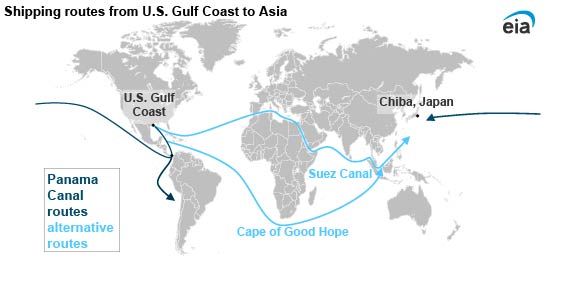A drought is limiting ship traffic through the Panama Canal. The resulting delays caused shipping rates through the Panama Canal for Very Large Gas Carriers (VLGCs) to reach record highs, which increased the cost of shipping liquefied petroleum gas (LPG) from the United States.
According to the Panama Canal Authority (APC), water levels at Gatún Lake are the lowest since at least 1995 as a result of an extended dry season and lower-than-normal precipitation on the Panama Canal. Gatún Lake is the artificial lake that vessels pass through to transit between the Atlantic and Pacific locks, and it holds the water supply needed to operate the lock systems of the canal.
VLGC rates have reached record highs because of the delays at the Panama Canal. Rates for VLGCs, which carry primarily propane (and, to a lesser extent, butane), on the Houston-Chiba (Japan) route reached $250 per ton for the week ending September 29, the highest since rates were first published in 2016. The Houston-Chiba route usually passes through the Panama Canal because it takes nearly half the time compared with going across the Atlantic and through the Suez Canal.
In August, Neopanamax-sized ships traveling through the locks had to wait at least 17 days to pass through the canal in all directions of travel. The unpredictability of waiting days resulted in some vessels, especially VLGCs, returning empty (ballast) from East Asia back to the U.S. Gulf Coast via alternative routes such as the Suez Canal or around the Cape of Good Hope, according to ship tracking data.

The Panama Canal is a major energy transit point. The Panama Canal is important for trade between the United States and East Asia and the western coast of South America. Vessels carrying petroleum products, hydrocarbon gas liquids (HGLs), and chemicals make up one-third of trade transiting the canal. Specifically, chemical tankers make the most transits, and HGL vessels (including VLGCs and Very Large Ethane Carriers) carry the most cargo by volume. Higher demand for U.S. propane in East Asia as a petrochemical feedstock is increasing demand for ship traffic through the Panama Canal and also contributing to the delays that are making this route a larger chokepoint.
Delays at the Panama Canal have pushed shipping rates higher elsewhere by decreasing the globally available number of vessels as more wait to cross the Panama Canal. More recently, however, the higher freight rates caused VLGC charterers to stay out of the market in October, which made more VLGCs available on the market and caused rates to fall to $176 per ton for the week ending October 13.










